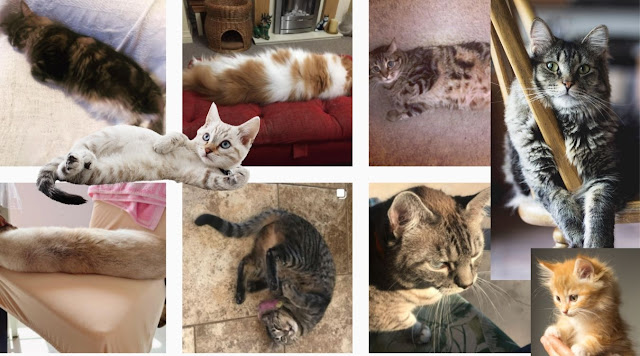Do you have a soft spot for cats? You'll learn more than one hundred exciting facts about our feline companions in this article. Discover little-known facts about cat behavior, statistics on cats, and information on why cats are such beautiful creatures in this article. Ailurophiles will adore this article, divided into sections covering each subject to make fact-finding simple.
Cats in general: some interesting facts
- A cat's jaws cannot be moved sideways in the same manner that yours can.
- A litter of kittens is referred to as a kindling.
- In contrast, a clowder is a group of adult cats who hang around together.
- The heart rate of a cat is twice as rapid as that of a person.
- Samantha and Tiger are the most popular cat names in the United States of America.
- Cats can tell if someone in a room has an animal hair allergy based on their behavior. No-one
- Is aware of the reason, yet they will attempt to sit on the other person's lap first. However, despite the nickname "Cheshire Cat" (and the figure from the story Alice in Wonderland), there is no such breed as a Cheshire Cat. This statement is related to the form of the mold used to make Cheshire cheese, which is designed to appear like a smiling cat.
- In most nations, a black cat crossing your path is considered bad luck, but, in Scotland, a black cat crossing your path is considered a harbinger of good fortune to come. According to legend, a black cat crossing your path in the moonlight foretold that you would perish in a terrible pandemic of sickness during the Medieval period in France and England.
- The Persian cat is the most popular cat breed in the world.
Statistics
- There are more than 500 million cats in the globe, according to estimates.
- There are around 100 different types of domestic cat breeds.
- A cat's waking hours are spent grooming itself, accounting for 30% of its total awake time.
- Throughout its life, the average cat purrs for more than ten thousand hours.
- The world's heaviest cat, which weighed about fifty pounds, was discovered.
- Cats sleep for sixteen hours every day, on average.
- A typical cat can run at a pace of 30 miles per hour on a flat surface.
- A cat can jump up to five times its height.
- Cats snore in around seven percent of cases. It was 30 years ago when the eldest cat gave birth to a tiny litter of only three kittens.
A Facts of kittens: Cats Have Some Interesting Facts About Them
- Cat urine can shine when exposed to a black light, which might aid in locating the source if it is accidentally released. You believe your kitty has had an accident in the home!
- Talking to your cat more often will result in your cat responding with more "talking" to you!
- The majority of cats do not have any eyelashes.
- Killing a cat was a capital offence in ancient Egypt, and the punishment was execution.
- Whereas in the United States, cats are referred to as "meow," in Japan, they are called "nyaa." When the noise was made in Ancient Egypt, it was called 'Mau,' which is also the name for a cat.
- It is horrifying to note that when people in England were executed for witchcraft, their cats were frequently executed alongside them. Awful.
- Cats are unable to detect sweet flavors.
- Cats were terrifying to Napoleon, the Emperor of France.
- Animal behavioralists believe that cats do not accidentally knock objects over by mistake.
- Either doing it for fun or catch your attention; they are rather clever, aren't they?
Cats' Physiology and Behavior
- Generally speaking, cats have four toes on each back foot, but five toes on each front foot!
- Some people believe that cats are color blind; however, this is not true! Cats can distinguish between the colors red, blue, and green.
- Puss was the name of the oldest cat ever discovered. She was 36 years old when she died.
- Cats have four rows of whiskers on each side of their face.
- The Maine Coon cat is often regarded as the most significant domestic cat breed in the United States.
- Unfortunately, many white cats with blue eyes are born deaf, which is a common occurrence.
- The field of vision of a cat is 220 degrees, but the field of vision of a person is just 180 degrees.
- Cats have an additional 24 bones in their body compared to humans. A cat's tongue is lapping up water from the bottom of its tongue rather than the top when it drinks.
- A cat's whiskers determine whether or not a space is wide enough for it to pass through. Wildcats and Big Cats are two types of cats.
- One distinction between domesticated and wild cats is that domesticated cats are more docile.
- While walking, breeds hold their tails straight up; wild cats hold their tails between their legs or horizontally, depending on the situation.
- The Scottish wildcat is the last major wild predator left in the United Kingdom.
- The Siberian Tiger, which may grow to about 4 meters in length, is the world's most giant wildcat. In contrast, the tiniest cat is the Black-footed cat, just 50cm in length. Several well-known 'beasts' exist worldwide that are believed to be large cats that have escaped from confinement. The 'Beast of Bodkin Moor,' which some belief is an escaped puma, is perhaps the most well-known monster in Europe. It is estimated that the cheetah can run at speeds more than 70 miles per hour, making it the world's fastest mammal.
- No two tigers have the same stripes pattern on their bodies as another.
- You can hear the roar of a lion from more than five kilometers away. Only lions prefer to live in huge groups, and they are the only cats that do so (called feelings of pride). A small number of breeders are crossing domestic cats with wildcats to produce hybrid breeds. While they may appear of exceptional quality, they are pretty expensive - and challenging to maintain!
Kittens Facts and Figures
- A female cat can bear more than 100 kittens throughout her lifetime. There is no guarantee that a litter of kittens will all come from the same father. There was a record-breaking litter of 14 kittens that survived 100 per cent of the time; the mother's name was Bluebell, and she was a Persian cat.
- In the same way, humans have teeth, and kittens are born with a complete set of teeth that fall off and are replaced much like humans!
- Sleep is essential for your kitten's growth since its growth hormones are only released when it is sleeping!
- Kittens despise unclean litter boxes and may frequently refuse to use them if they are not clean.
- When a kitten is born, its heart beats around 250 times per minute for the first few minutes. Cats are born with blue eyes, and it is only when they are exposed to light that their eyes begin to change color.
- The fact that kittens dream when they are asleep has been demonstrated repeatedly.
- Important piece of advice: do not give your kitten grapes or raisins since they might cause renal failure in cats.
The Behavior of the Cat
- To mark their territory, cats paw at the ground. They sweat through the bottoms of their paws (and the perspiration includes fragrance), which they rub on the ground to indicate their territory. In the presence of a cat, the little quivering its tail indicates that the cat is completely smitten and adoring of you.
- If, on the other hand, the tail is thrashing, it is clearly in a foul mood! The act of a cat squeezing its eyes shut indicates contentment.
- Cats may be taught to use a human toilet instead of a litter box if given the proper training. Amazingly, some cat owners have even taught their animals to flush after they have gone!
- Just because your cat delivers you a dead mouse or bird does not mean it is sending you a gift. According to some animal behaviorists, the cat believes that you are a lousy hunter and brings you prey because it believes that you are incapable of capturing the prey of your own.
- According to scientists, cats do not consider themselves to be little people; instead, they consider humans to be giant cats!
- If your cat is terrified, covering its eyes will enable it to relax and become calm.
- Your cat turns over onto its back and exposes its tummy to you, it indicates that it has confidence in you. The fact that your cat licks you indicate that it loves you.
Cats are wonderful creatures!
- Cats can produce 10 times the number of vocal noises that dogs are. In terms of eye size concerning body size, cats have the enormous eyes of any mammal.
- The way a human's brain functions is more comparable to that of a cat than that of a dog.
- During both world wars, sailors frequently purchased cats as ship mascots. They utilize to keep rodents away from food sources, and they were frequently provided with their hammocks to sleep in! A cat can recognize the individual footfall of its owner from up to one hundred meters distant.
- Your cat's tongue is coated in several small hooks that assist it in ripping apart food while it is in its mouth.
- A cat can turn ten times faster than the most outstanding watchdog in the world in the direction of a sound it detects.
- Your cat's hearing is exceptional - each ear can be rotated independently and with a range of 180 degrees, giving him a wide range of hearing.
- Americans own 73 million cats compared to only 63 million dogs, indicating that cats are the more popular pet. Because cats do not have a collarbone, they can squeeze through practically any aperture more diminutive than their heads!
Cat's Other Interesting Facts
- When a cat nips at you while you are patting them, it is their way of informing you that they appreciate the attention you are giving them.
- Female cats develop more quickly than male cats - they can reach maturity in as little as five months, whilst male cats can take nearly twice as long!
- To ensure that their digestive tract remains clean, cats consume grass to allow them to vomit hair and other irritating substances.
- The majority of cats are lactose intolerant, which means that consuming milk causes them to have stomach pains and diarrhea. Science believes that cats respond better to female voices because they are higher in pitch than male sounds. Bezoar is the scientific term for a cat's hairball in its natural state.
- Felicitate was the name given to the first cat to travel into space, which came from France. You'll be relieved to know that she made it through the journey. It was a cat who served as the fairy godmother in the original version of Cinderella (which was recounted initially in Italy). When cats meow, they almost always communicate with people; they seldom do so to communicate with other cats! A cat exhibition was first staged in London in 1871, and it was the first of its kind in modern times.
The Most Amazing Facts You Should Know
- A cat's nose has a distinctive pattern, similar to a human fingerprint!
- Who was the inventor of the cat flap? Amazingly, the guy who established the laws of gravity, Isaac Newton, was responsible!
- Every year, Americans spend more money on cat food than baby food!
- In 1879, the Belgian Post Office attempted to carry mail using 37 cats, which failed. Initially, it worked, but the cats were not disciplined enough to keep up with the programmed.
- People frequently inquire why there is no cat food with a mouse flavoring. This is because cat food businesses have attempted to produce it, but cats have not responded well to it in studies.
- The ancient Egyptians revered cats. If a cat died, the family who 'owned' the cat would shave their brows to symbolize respect and sorrow for the animal's passing. A cat is recommended for people who suffer from high blood pressure since it has been established that petting a cat can help decrease blood pressure! Several studies have found that cats respond most positively to names that finish in the sound 'ee'.
- A cat named Towser worked at the Glenturret Distillery in Scotland, where he captured approximately thirty thousand mice over twenty-four years of employment. As a result of her untimely death, she was replaced with a cat named Amber. Amber was never successful in catching a single mouse.
- During World War II, a cat was given the Dickin Medal for Bravery, the equivalent of the Victoria Cross in the animal world.
Tags:
baby-cat-ear-headphone
bengalcat
cat
cat-backpack
cat-cafe
cat-carrier
cat-clipart
cat-emoji
cat-grass
cat-harness
cat-life
cat-mamas
cat-ninja
cat-sounds
cat-war
cutecat
dojacat
kit-cats
lovely-cats








